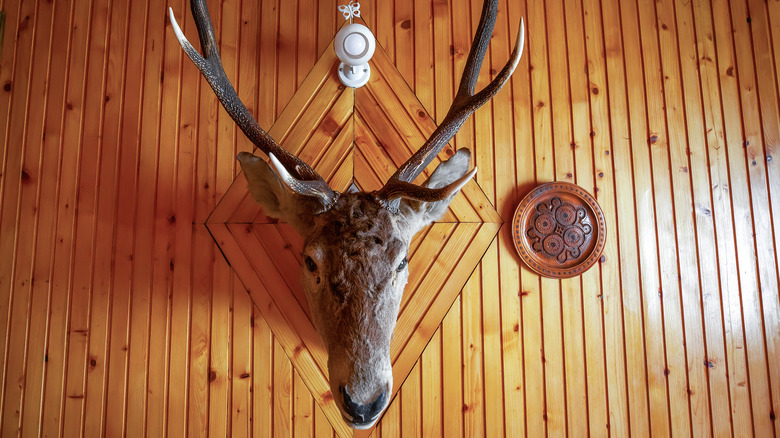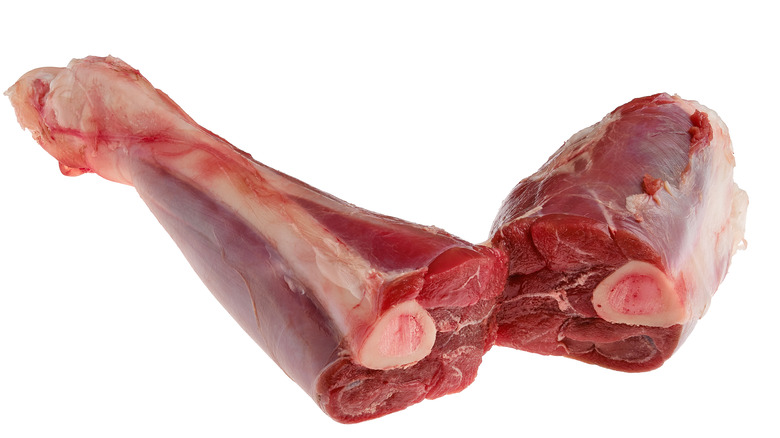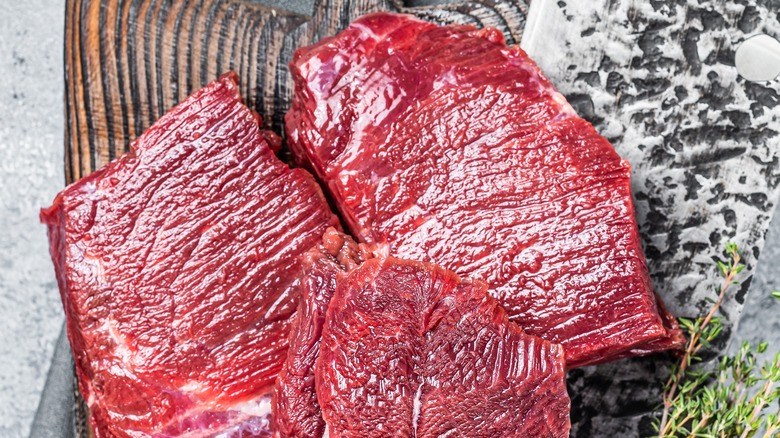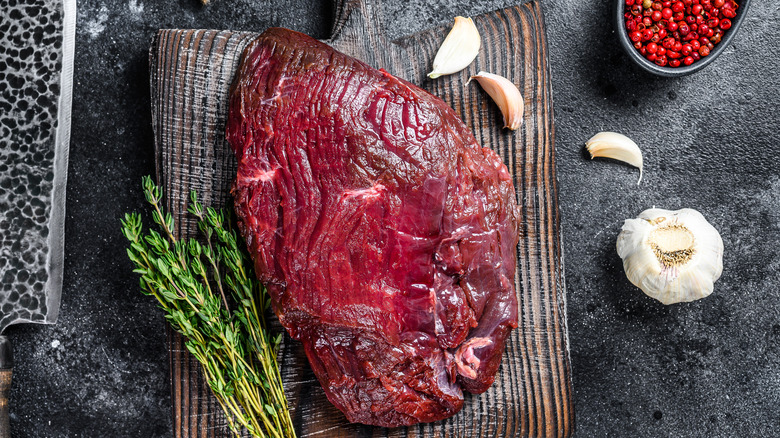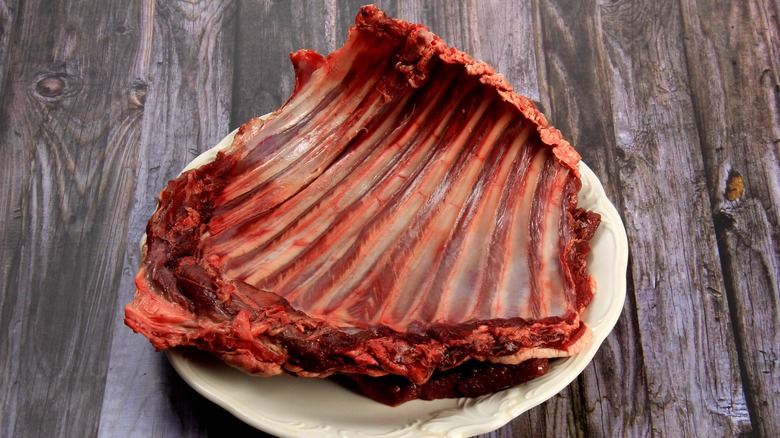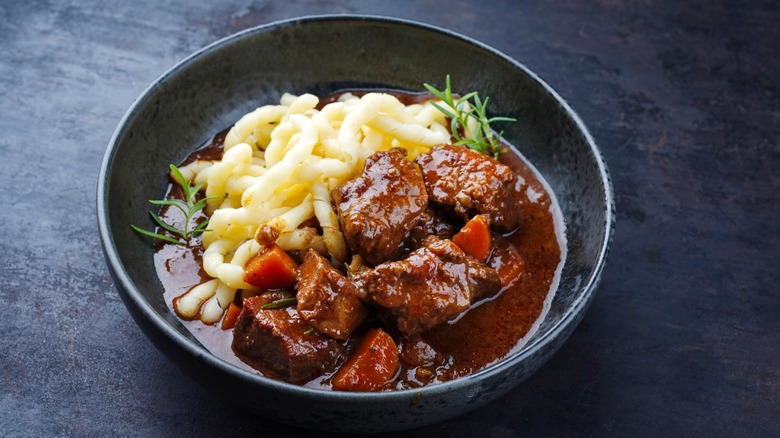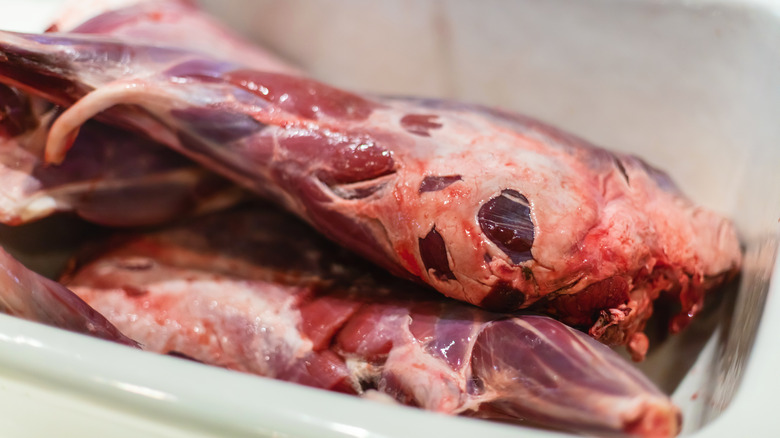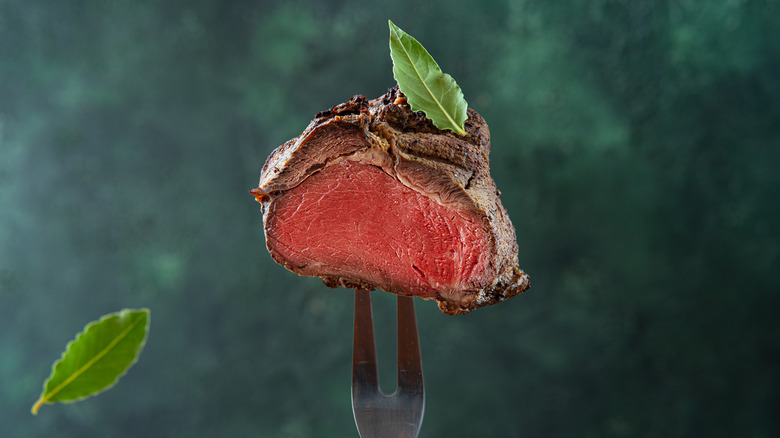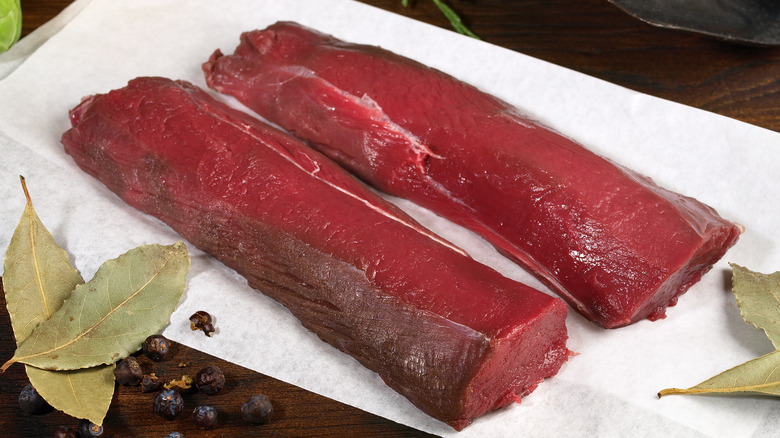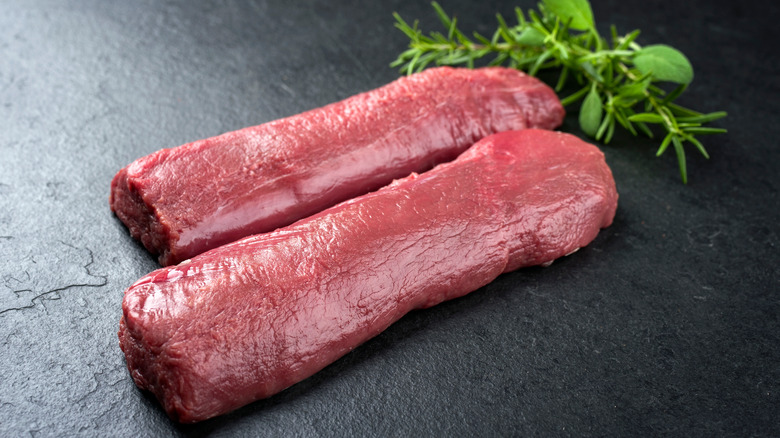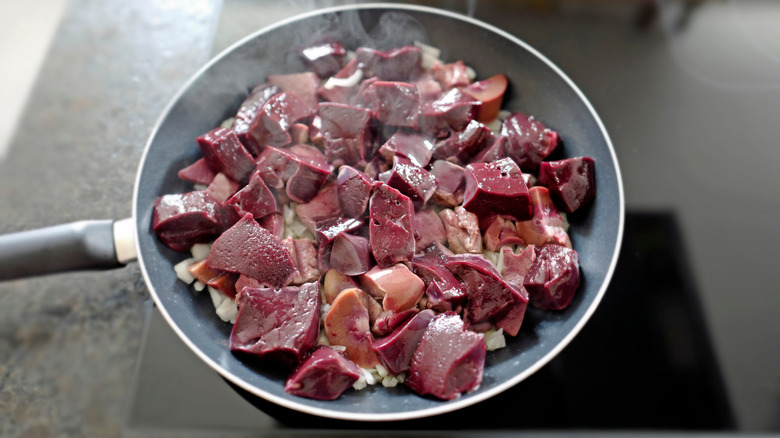Every Cut Of Venison, Explained
Ask a hunter what cuts they receive from a deer processor, and the answers will almost patently be the same because when faced with a whole animal, many people lack the knowledge and ability to articulate what they would like. Chef David Bancroft of Acre and Bow & Arrow restaurants in Auburn, Alabama, pulled back the curtain on deer processing. "If you want grocery store meat, wrapped up and labeled in a package, you've gotta go there," Bancroft says. "If you want [the processor] to break down your deer and give it back to you [the way you want it], you have to know what you want and know how to ask for it. They can only recommend [what they can give you] and will only give you the list of hits to choose from."
Lacking familiarity with the larger variety of cuts they can choose from, "People will say, 'Well, I'll take some steaks and sausage, then,' because that's all they know," Bancroft continues. "When you go into a processor, you have to have a target and build a relationship with [the processor]," or you'll only get the hits." To help you decide what you want and, just as importantly, how to ask for it, Bancroft agreed to help us explain the primary muscle groups and cuts of venison.
Shank
We have to start somewhere on the deer carcass, so we might as well start at the bottom. The shank is the upper part of the leg before it joins the body. Picture the area between your knee to a few inches below your hip or your arm along the length of your bicep. The lower legs contain some meat but are best left for the stock pot when assessing the work-to-yield return.
The shank is full of sinew and connective tissue, making it tough and chewy. So what do you do with it to make it pleasant to eat? For the least amount of knife work, you can braise the shanks whole, like one would a lamb shank. As a deer's shank is larger than a lamb, you could cross-cut the shank with a hack saw, or bone saw for venison osso bucco. When not feeling the osso bucco preparation, Bancroft removes the meat from the leg bones and then uses it for curries or other types of stew. He'll also toss the meat onto the "grind pile" to process into venison sausage. The bones go onto another pile destined for stock so as not to waste any part of the animal. It was a sentient animal drawing breath a short time ago; not fully utilizing it would be disrespectful.
Chuck/Shoulder
On a cow, the shoulder, or chuck, is a very versatile piece of meat. A butcher can cut steaks or roasts from the chuck, and the well-marbled flat iron steak is buried deep inside at the shoulder blade. On a pig, the shoulder — also called the Boston butt or just butt — can be a roast, BBQ, steak, the source of the best sausage, or country-style pork "ribs." A collection of muscles called the coppa lies in the center of the butt and is often cured for capicola. None of these descriptions apply to venison, unfortunately.
While it's understandable to assume the shoulder would at least make good stew meat, "A deer's shoulder is built for jumping, running, and leaping," Bancroft explains. "Cows and pigs just don't do that." Because of the different activities the animals engage in, "there's very little intramuscular fat," he says. "That's why it's my first candidate for the grinder." But he warns against just simply grinding venison. "It's incredibly lean, and it comes out of the grinder with this pasty texture," he says. For that reason, he advises augmenting the meat with another animal fat, such as pork fatback or, his preference, beef suet. Ideally, you want at least an 80/20% lean-to-fat ratio. Why not venison fat? Bancroft explains that the gaminess people often experience in venison is due to the high concentration of stearic acid, the same compound that makes lamb gamey, and alternative fats minimize that.
Flank
Venison flank and beef flank share a little in common. It takes a bit of work to make it the best due to the connective tissues in the meat, but that doesn't mean a venison flank has no worth outside the grind pile. Remember, it's connected to the belly, which has such a large streak of silver skin running through it that cooking techniques will not tenderize. To start, remove the layer of silver skin that covers both sides before cooking; else, it will pucker up instead of lying flat when cooking. With that bit of knife work out of the way, you have a lean, striated slab of venison that you can cook over a very hot fire or pan and then slice cross-grain to eat as-is or for use in fajitas.
Bancroft likes to slice the flank into thin strips, pound them, and then use them in place of bacon to wrap around jalapeños stuffed with cream cheese before grilling. He's also pro-jerky, and the flank yields good strips for smoking. He marinates his jerky, with the last batch taking a bath in ranch seasoning before meeting the smoker. But he doesn't stop with marinade suggestions at jerky; he's a strong proponent of marinating any cut of venison before cooking. What's the proper venison marinade? "The one that makes you happy," he says.
Ribs
We'd all like venison ribs to be more rewarding than they are, giving us unctuous, greasy, cartilage-laden bits of slow-cooked goodness like beef and pork do. But venison is either of those; the meat is tougher and less fat-laden. Bancroft will pull the flap meat from the ribs for grinding, removing a layer of silver skin on each side, leaving a very thin layer of meat to work with, and then add the ribs to the bone pile for stock.
Another way of dealing with them is to braise them. After removing the noxious fat and external layer of silver skin, you can slow cook them for several hours, which renders the intramuscular fat and reduces the waxy texture and gamey flavor. The meat will release from the ends of the bones and gather in the middle, which makes it easier to remove, in a way. After allowing the ribs to cool in the braising liquid overnight, one choice is to place them on a hot grill or pan to crisp the outside before glazing them with the gelatine-rich braising liquid. You can also remove the meat from the bones, shred it, and use the braise to create a rich ragout to serve with pappardelle or similar wide, ribbon pasta.
Neck
Often overlooked because most can't picture the value, the neck is one of Bancroft's favorite cuts from a deer. "Because of the amount of connective tissue in the neck, it's very versatile," he says. The connective tissue, which yields collagen during cooking, makes the neck a prime candidate for slow roasting or smoking, one of the few parts of a deer that benefits from slow cooking. The neck is also a perfect braising meat, particularly in a stock made from roasted neck bones. One of Bancroft's favorite preparations is braising the neck meat with a pepper mash to make curry or other "rice and gravy" (in Southern parlance) type dish. The richness of the collagen makes these stews almost sticky on your fingers and provides an incredible mouth feel. Keeping along the same lines and nodding to his Texas origins, he claims that venison neck makes the perfect birria. He shreds the meat to fill tacos while utilizing the neck and other collected bones to produce a broth richer than most goat or beef-based versions.
Leg/Round
There are two ways you can go with a venison leg. You can bone out the leg and separate it into major muscle groups, or you can leave it bone-in. If you leave it bone-in, you have an excellent piece for roasting whole, either on a spit or in the oven with the traditional root vegetables for a proper English haunch. You can also brine the leg and smoke it, making the venison version of a store-bought holiday ham. You can also dry-cure it for prosciutto or country ham; the difference lies in the spices you cure it with and whether you smoke it after salting.
Off the bone, you'll have an elongated cut, the bottom round, suitable for roasting whole. If whole-roasting isn't what you have in mind, the bottom round is an excellent cut for scaloppine or cutlets. Sitting between the top and bottom rounds is a bit of treasure, the eye round. The eye round is an elongated triangular-shaped muscle that slightly resembles a tenderloin. Because the eye round gets considerably more use, don't expect tender meat from this well-developed muscle. "I like to pull the eye round and air-cure it for bresaola," Bancroft says, referring to the air-dried charcuterie, typically made from a beef eye-round. The eye round is also a good candidate for hot-cooking on a rotisserie, which you could then shave like roast beef for sandwiches or just eat as-is.
Rump
The rump is one of Bancroft's favorite places to harvest meat for tartare, mainly where the muscles from the loin join it. The rump, or top round, is a mass of muscle that sits on top of the back leg. After removing it from the bone, you'll have a semi-spherical cut suitable for roasting whole. If a whole roast isn't in your future, you can continue to break the rump down into more usable pieces. As with the bottom round or sirloin, you can always thin-cut and pound slices from the rump to make scallopine. Another easy use for the top round is to cut your pieces thicker for medallions, which you can quick-grill or pan-sear for a standalone dish or use for fajitas or sandwiches.
Typically, the top round comes off the bone along with the sirloin, which is a much smaller cut on a deer than on a cow but equally valuable. You can cut a few steaks from the sirloin, cut thinly across the grain for scallopine, or slice it for jerky.
Loin/Backstrap
"Backstrap" is the most popular cut from a venison carcass, mainly because it's the easiest to remove in the field, the easiest to cook, and the most recognizable. Depending on how you want to cut it, you can take T-Bone and Porterhouse steaks from it, chops (or tomahawk ribeyes), or grill, smoke, or roast it whole. If that wasn't enough, Bancroft also notes that "It's the quickest place to cut jerky from."
We've mentioned that it's easy to cook, but you need to take care with the loin or any cut that you're not going to slow cook. Bancroft warns not to cook venison past medium rare (135 degrees Fahrenheit) to keep the meat tender and moist. Even when smoking a backstrap, you want to heed that medium-rare warning and keep a water pan in the smoker to help keep it from drying out. Another thing Bancroft warns never to do is wrap your backstrap in bacon. While the reasoning for wrapping a very lean piece of meat in fat before cooking is sound in appearance, the reality is quite different. "When you wrap a backstrap in bacon, the bacon on the outside gets crisp, but what you're doing to the venison inside is steaming it, making it dry and gray," he says. If you don't trust your skills and absolutely must add fat, which muddles the venison experience, consider "larding" the meat by adding strips of fat to the inside of the backstrap with a special needle instead.
Tenderloin
You can have a tenderloin or a Porterhouses and T-Bones, but you can't have them all. These steaks all come from the loin, each with the loin on one side of the bone and the tenderloin on the other. So if you remove the tenderloin, you can't have the two types of steak that contain it.
The tenderloin sits at the back end of the loin on the inside of the ribs. Because of that location, it doesn't get much of a workout in the daily life of a deer, which means it's almost luxuriously tender. There's also very little, if any, fat. So you have this beautifully lean, tender piece of meat with very little opportunity for the stearic acid in the fat to lend any trace of gaminess. The leanness is why Bancroft says, "The tenderloin is the best possible introductory piece of venison for people who say they hate game meats. You just marinate it, skewer it, and fast-cook it." Again, his marinade recommendation is whatever you like; Italian salad dressing, wine, ranch seasoning, what have you. There's not much substance to a venison tenderloin when comparing it to beef or even pork, but the reward is worth the cost.
Offal and Bones
Now that you've removed all the primal cuts from the carcass, cubed your stew meat, and ground your scraps, you have a few more pieces to deal with. Before you get all squeamish, the heart is a fantastic muscle for eating. You'll need to remove the sinewy valves, but after that, you can dice it to make tartare. The meat is sweet, clean, and delicate, according to Bancroft, who served a freshly harvested heart tartare to chef David Chang in years gone past. The heart is also fantastic after marinating in vinegar and spices and quickly grilling the pieces on skewers to make anticuchos. The liver is similar in flavor to beef, with a little more pungency. The head meat yields cheeks similar to beef, and the tongue is excellent when slow-braised to make tacos de lengua.
And then, we've mentioned bones throughout this article. Venison bones make excellent stock, full of collagen, yielding a rich texture that coats your tongue. For best results, roast the bones first until they're well-browned, then simmer them with aromatics for about eight hours. Drain the stock, but retain the bones. Add fresh aromatics and repeat the process to get a "second wash" from them. For extra richness, you can boil the strained second wash, skimming any foam that comes to the surface until the stock's volume reduces by half to intensify the flavor and richness.
